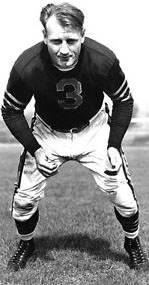
Bronko Nagurski
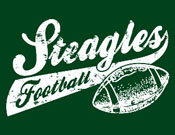
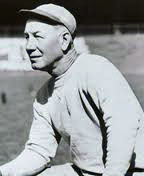
Earl "Greasy" Neale
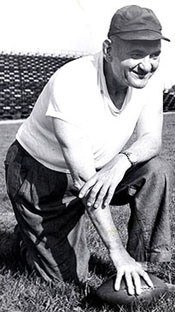
Walt Kiesling
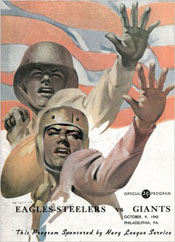

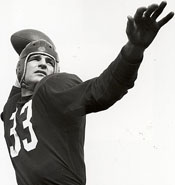
Sammy Baugh

Frankie Sinkwich
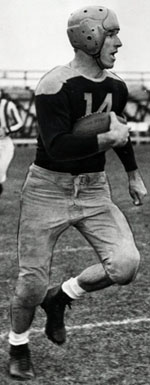
Don Hutson
|
The Steagles
Looking ahead to the 1943 season, the second one since the U.S. entered World War
II, the National Football League faced a major problem.
- Like
baseball, most of the players had been drafted by the armed forces. Unlike
baseball, the NFL did not have a vast minor league system to draw on.
- The
league had limped through the 1942 season with about 1/3 of its players in
the service. Attendance plummeted 20%.
At
its annual meeting in April, 1943, the NFL took stock.
- 150 more players had
been lost to the armed forces. Most teams were decimated.
- The Pittsburgh
Steelers had only six players under contract. The Philadelphia Eagles had 16, more than most clubs.
- With owner Dan Reeves serving overseas, the Cleveland Rams received permission to drop out of the league for the
1943 season.
- The good news from this move was that the Rams'
14 players could be disbursed among the nine remaining clubs.
- The bad news
was that an odd number of teams created a scheduling problem.
The
1943 draft was mostly a waste of time as almost all the college draftees were
already military draftees. Some players were coaxed out of retirement, led
by the legendary Bronko
Nagurski, who joined to the Bears at age 35 after 5 idle years.
However, the Steelers still faced dire
straits and might have to shut down as Cleveland had done.
- The Pittsburgh problem
and the scheduling dilemma were solved by merging the Steelers
with their cross-state rivals, the Eagles,
for the 1943 season.
- The team would play four of its home games at Shibe
Park in Philadelphia and two in Pittsburgh at Forbes Field.
- Earl
"Greasy" Neale of the Eagles and the Steelers' Walt
Kiesling would be co-coaches. (This arrangement worked only after
Neale took over the offense and Kiesling
the defense.)
- The uniforms were the green and white of the Eagles.
League standings would list the club as Phil-Pitt. However,
sportswriters and fans preferred "Steagles."
15
of the 24 players on the team had been rejected by the military because of
physical problems ranging from flat feet to ulcers.
- Tony Bova
was blind in one eye; Ray Graves (later coach of Florida)
was deaf in one ear.
- The remaining players received deferments because of
family obligations.
The Steagles were the only pro sports
team to require its players to work in defense-related industries.
- Almost
all lived in Philadelphia, where they worked regular jobs during the day and
practiced at night.
- Ex-Steeler
T Ted Doyle lived in Pittsburgh and commuted to games on
weekends.
Phil-Pitt fielded a solid roster.
- The line was anchored by Frank "Bucko" Kilroy, Vic Sears, and young Al Wistert.
- Johnny
Butler and Jack Hinkle were good ball carriers out
of the T-formation that Neale had copied from the Bears.
- Lacking a good QB, the passing game was weak. The backup QB was Allie
Sherman, later coach of the Giants.
Steagles Starting Lineup
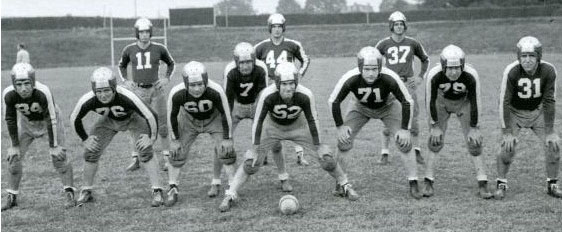
Line (L-R): Larry Cabrelli, Frank "Bucko" Kilroy, Eddie Michaels, Ray Graves, Elbie Schultz,
Vic Sears, Bill Hewitt; Backs (L-R): Jack Hinkle, Roy Zimmerman, Ben Kish, Ernie Steele
The
team did surprisingly well.
- After two exhibition games (one in each home city),
they opened the regular season with a 17-0 win over the Brooklyn
Dodgers before 10,000 under the lights at Shibe Park.
- The following week 15,000 turned out to see the Steagles upset the New York Giants 28-14
despite having two punts blocked, throwing three interceptions, and fumbling
ten times (still an NFL record).
The Steagles then hit a rough patch.
- Buoyed
by the 2-0 start, the team was pasted by the Bears 48-21 at Wrigley Field and by the Giants 42-14 at the Polo Grounds.
- A 34-13 trouncing of the lowly Chicago Cardinals at Forbes
Field in Pittsburgh put Phil-Pitt back on track.
Then
they pulled off another upset, holding the defending champion Washington
Redskins to a 14-14 tie before 32,693 – the largest
NFL crowd yet in Philly.
- The tie ended Washington's
13-game winning streak.
- The defense harassed the Redskins'
great QB Sammy Baugh all day, twice ripping the jersey off
his back – literally.
After
the high, a letdown – a 13-7 upset at Ebbets Field at the hands of the
last place Dodgers.
- However,
the Steagles bounced back to
defeat the Detroit Lions at
Pittsburgh 35-34 in "one of the wildest games ever played in the National
Football League."
- 0-11 in 1942, the Lions were energized by the return of Heisman Trophy winner Frankie
Sinkwich, who was discharged from the Army because of flat feet.
- The Lions scored on a 98y
kickoff return, an 88-yard pass-and-lateral, and a 71-yard pass but lost because
of a missed PAT.
For
their second-to-last game, the Steagles
traveled to Griffith Stadium for a return match with the Redskins.
- Washington had just handed the Bears their first regular season
defeat in 23 games even with Baugh sidelined with an abscessed
tooth and bruised knee.
- The expected revenge by the capital team never materialized.
- With Baugh playing but gimpy, the Steagles
won 27-14.
 Redskins
Redskins' RB Wilbur Moore makes over the shoulder catch at Griffith Stadium, Washington
The amalgam team could tie for first in the East depending on the
outcome of the remaining games.
- It
was not to be. First of all, the Steagles
didn't do their part, losing their final game 38-28 to the Green Bay Packers before a new record crowd of 34,294 in Shibe Park.
- Don
Hutson, in what was supposed to be his NFL swan song (before
Curly Lambeau talked him into playing one more year), caught
two TD passes and kicked a FG and five PATs. His 117 points led the league
by far.
- Despite the loss, the Steagles'
5-4-1 record produced the first winning season of the Philadelphia
franchise and only the second for Pittsburgh.
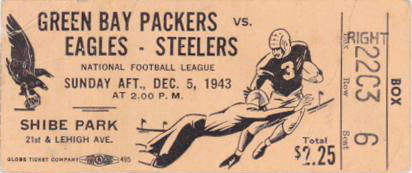
Colorized Steagles- Packers action
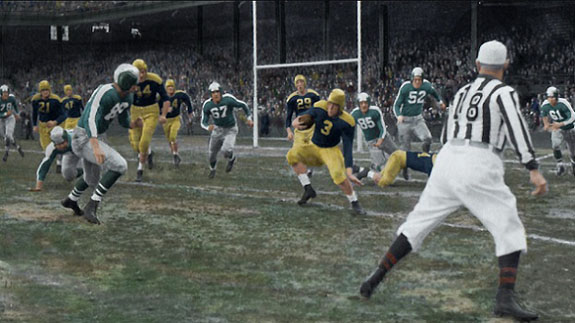
Tony Canadeo (3) runs at Shibe Park as Tom Miller (89), Ed Conti (67),
Tony Bova (85), and Ray Graves (52) encircle him.
After losing two straight to the Giants to end the regular season, the Redskins defeated New York in the Eastern Division playoff.
- But the Bears got revenge for Washington's victory in the '42 title game.
- They knocked Baugh out of action on the first series and romped 41-21 in Chicago.
- Nagurski scored a TD in his final NFL game. He retired "for good" after the season.
The patchwork '43 season was a success as attendance rose to an all-time high.
For
1944, the Eagles fielded their
own team, while the Steelers
merged with the Cardinals.
Postscript:
On the last day of 1943, Branch Rickey, general manager of
baseball's Brooklyn Dodgers, warned
his fellow executives that pro football was on the verge of becoming America's
new national pastime.
Reference: Last Team Standing: How the Pittsburgh Steelers and Philadelphia Eagles - The "Steagles" - Saved Pro Football during World War II, Matthew Algeo (2007)
|










